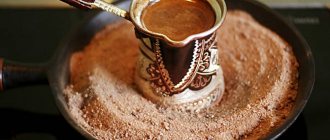Secrets of making Armenian coffee
In Armenia, the coffee drink is prepared using a special technology. To achieve the desired result, it is extremely important to adhere to the following recommendations:
- You need to use lightly roasted grains , crushed literally into dust. Due to this, it is possible to obtain a light, unobtrusive aroma and delicious taste.
- Before grinding, the grains must be roasted and only then crushed. These steps are performed immediately before starting the cooking process.
- Coffee acquires its exquisite taste when cognac is added to it. It is customary to pour alcohol during brewing, and not into a cup with the finished drink.
- It is unacceptable for the liquid to boil . In Armenia, it is believed that if coffee boils in a cezve, it will become unfit for consumption.
- The drink is served with foam. Therefore, you need to pour it into a cup as carefully as possible.
Making Armenian coffee is not at all difficult. To do this, you just need to follow the proportions indicated in the recipe and follow the step-by-step instructions. In this case, you can be sure that the result of your work will pleasantly please and surprise you.
Coffee is a drink that has conquered the entire globe. Each country has its own traditional recipe for its preparation with additives that give the drink a national flavor. In Ireland it is Irish whiskey, in Italy it is liqueur, and in Armenia it is the famous Armenian cognac.
Coffee capital – true or false?
It is quite logical to assume that since there is Armenian coffee, it means that it grows in Armenia. But this is a strong misconception. In fact, the product with this name is Colombian, and Armenia is one of the main cities of the coffee industry in Colombia, whose first settlers were Armenians.
The warm and mild climate of South America is favorable for the cultivation of elite coffee varieties all year round, which is why Armenia is called the “coffee capital” of Colombia.
The town also has a developed tourist destination. This is where one of the coffee museums is located, which both lovers and real connoisseurs of the invigorating drink are eager to visit. It presents varieties of varieties, cooking devices, and history. And if you arrive in the city at the beginning of summer, then you have every chance to get to the National Coffee Festival, which is held every year.
- How to brew delicious and aromatic coffee in a Turk on a gas stove
And even though coffee does not grow in Armenia (a state in Transcaucasia), the country has its own coffee traditions and unique cooking recipes.
Coffee drinking in Armenian style
Translated into Armenian, the word “coffee” sounds like surch or surch. It is believed that it is no less popular among Armenians than tea, and if you come to visit, the first thing you will be offered is a cup of aromatic strong drink according to a special recipe.
Classical
The secret of preparation lies in fine grinding, literally into dust. Before grinding, the beans are roasted until lightly toasted and then ground. The second secret is to try not to bring the drink to a boil; it’s better to brew a new one. This is similar to the traditional Turkish brewing method.
For 1 serving you will need:
- 7-14 g of freshly ground coffee (which corresponds to 1-2 tsp);
- 1 tsp sugar or a piece of refined sugar;
- 3-4 drops of cognac;
- water.
How to cook:
- Pour/pour all the ingredients into the Turk.
- Cook over low heat. As soon as foam appears, remove from heat without letting it boil.
- Pour into a cup. Armenian coffee is ready to be served.
With fine grinding, the aromatic properties are less lost during storage. This is explained by the fact that coffee particles adhere more tightly to each other, and therefore are less weathered. Ideally, coffee should always be freshly ground.
Second cooking option
It will require the same ingredients as in the previous recipe, only the sequence of actions will change.
- Mix 1-2 tsp in a cezve. finely ground coffee and 1 tsp. Sahara.
- Heat the dry mixture over low heat.
- Pour in cognac at the tip of a teaspoon and water.
- Cook until coffee foam appears. Remove from heat and pour into a nice serving cup.
The usual dosage of coffee is 1-2 tsp. or 7-14 g of powder per 1 cup. You should not brew a stronger drink for 3-4 tsp, as this can lead to health problems and coffee addiction.
In Yerevan
A distinctive feature of the recipe is the small amount of water (a teaspoon of powder per 60 ml coffee cup). You will need:
- The best coffee and pepper recipes for health and figure benefits
- freshly ground finely ground coffee;
- sugar to taste;
- water (bottled).
How to cook:
- Pour coffee into a turkah, ideally using srjept (an Armenian version of turkah, which is a copper or cupronickel silver vessel with a bent spout and a long handle).
- If desired, add sugar to taste.
- Fill with water and place on low heat.
- When the mixture is well heated, it must be stirred quickly, once.
- Then cook until a light foam appears. Do not stir so as not to disrupt its integrity.
- As soon as the foam rises slightly, remove the coffee maker from the heat.
- Pour foam into a preheated cup (just rinse with hot water) and add ready-made coffee.
The rule “lots of coffee, not enough water” is conditional, deviations are allowed. You should not use the specified proportions exactly. You need to focus on your taste and preferences, as well as your state of health.
With cognac and alcohol
What’s interesting about this drink recipe is its presentation. You will need:
- 1-2 tsp. freshly ground coffee;
- 2-3 drops of any Armenian cognac (on the tip of a teaspoon);
- a piece of refined sugar;
- 2-3 drops of alcohol (on the tip of a teaspoon);
- 100 ml water.
How to cook:
- Brew coffee without sugar in any convenient way. Pour into a cup.
- In a dessert or tablespoon, set a piece of refined sugar on fire, after dousing it with cognac and alcohol.
- Once the fire goes out, add burnt melted sugar to the cup of drink and stir.
There is a variation of brewing coffee with sugar, and cognac (which can be replaced with rum, alcohol, absinthe) can be set on fire separately and evenly distributed among the cups.
There are many coffee recipes with cognac, including Danish, Dutch, French, there is even a Turkish mocha option and others.
It is worth remembering that coffee should be consumed in moderation, and even less if alcoholic beverages are used as an additive.
Guests will certainly enjoy the original presentation, and the drink will pleasantly surprise you with its strength, exquisite taste and aroma.
photo: depositphotos.com/AChubykin, Bernashafo
Coffee is in first place in terms of consumption in Armenia. Its locals love it more than tea. Surch is what the Armenians call coffee; it has its own characteristics in preparation. Next we will learn more about this coffee brewed in Armenian style.
Hospitable Armenians always have coffee for their guests. If you come to their house, the hostess will definitely treat you to coffee in Armenian style. This drink will be different from any you have ever tried before. Because the locals cook it with love and every family keeps its own secret of its preparation.
Recipe for burning coffee in Armenian.
This recipe is more suitable for a male company due to the spectacular way of serving the drink. To prepare burning coffee we need the following:
- water – 0.2 liters;
- ground coffee - 2 tablespoons;
- sugar to taste;
- rum - 1 tablespoon.
Making burning coffee in Armenian style.
Pour ground coffee, sugar into the Turk and add water. Place on the stove, bring to a boil, remove from the stove. Let sit for 3 minutes and pour into cups. Pour rum into a ladle and set it on fire. Pour the burning rum equally into the cups of coffee. It is permissible to replace rum with absinthe, alcohol, or cognac.
This is also interesting:
- Coffee and chocolate Coffee and chocolate are one of the most harmoniously combined flavors in cooking. The tradition of combining coffee with chocolate appeared in the 18th century, when chocolate was a […]
- Royal Coffee Royal Coffee got its name not only because of its pleasant and dense taste, but also because of the luxurious appearance of the finished drink. To prepare coffee according to this recipe, use egg [...]
- How to make coffee with cognac Coffee with cognac is a kind of low-alcohol cocktail that perfectly tones. However, in order to get a tasty drink that will give a powerful boost of energy, it is necessary [...]
- Espresso coffee in a Turk Anyone who has tried espresso coffee made in a carob coffee maker for the first time wonders: is it possible to brew espresso in a Turk? In order to answer this question, you need [...]
How to prepare an Armenian aromatic drink?
If the coffee is fresh, just roasted and ground, then it can be easily identified by its smell. Any coffee lover can easily figure out where the coffee is of high quality, and where it is no longer fresh - it has absorbed unnecessary aromas. Armenians try to brew the drink from fresh coffee beans, as they know a lot about this drink.
How to brew coffee in Armenian?
Ingredients:
- fine coffee bean powder - 8-15 g;
- sugar - 15-18 g;
- cognac - 4-6 drops;
- water - 125 ml
Preparation:
- Add all of the above products to the Turk. At the very end, fill them with cold purified water.
- Place the vessel on the stove and cook on low gas until the coffee begins to foam and rise.
- Remove the Turk from the oven, and after 30 seconds put it back there. Do the same thing again as in the previous point.
- After brewing three times, pour the finished strong drink into a coffee cup.
To ensure that the coffee is aromatic and not too bitter, fresh beans are roasted over low heat until lightly roasted.
If you don’t have time to roast coffee beans yourself, then purchase ready-made beans at coffee stores. Do not take many servings at once to brew a drink - they will lose their quality.
How to brew Armenian coffee in a Turk
At first glance, it seems that there is nothing special in the recipe for making Armenian coffee. As usual, use 1-2 teaspoons of coffee in half a glass of water. At the same time, sugar is added, which also does not contradict Armenian traditions.
However, there are certain nuances of how to brew coffee in Armenian. First of all, you should never rush to stir the coffee powder before it gets wet and sinks in the water. Only after it is completely wet can you start stirring. According to the traditional recipe, coffee can be stirred once.
After the temperature of the water in the Turk reaches 90°, you need to remove the foam from the surface and carefully place it on the bottom of the coffee cup. The temperature can be determined by the presence of bubbles and the rise of foam. It is laid out among all the cups, and then the Turk is put back on the fire and continues to cook.
Then wait for the foam to form again and remove from the stove. It is very important not to bring the drink to a boil during preparation. Now you can pour the remaining coffee into cups. This way it is better to cook two servings at once. The taste will be rich, and the coffee foam will be perfect.
How to prepare a burning drink in Armenian?
Men will especially like this coffee because of the special effect when serving it. It is easy to prepare and can even be done at home.
Ingredients:
- water - 195 ml;
- coffee powder - 25-35 g;
- sugar;
- rum - 35 ml
Preparation:
- Pour coffee, granulated sugar into the cezve, and pour clean water from the source.
- Place on the stove and brew like espresso.
- Then let the drink sit for three minutes, pour it into cups.
- Pour the Rum into a large stainless steel spoon and set it on fire.
- Carefully pour into cups.
Treat your guests to this coffee right away so that the rum does not have time to go out in the cups.
The same burning effect can be achieved by adding burning alcohol, vodka or cognac to coffee.
Secrets of making delicious Armenian aromatic coffee
According to statistics, in Armenia almost every local resident drinks more than three kilograms of the drink. Despite the fact that coffee is not grown here, its popularity does not fall.
Local gourmets prefer finely ground and lightly roasted coffee beans. Thanks to this, the drink turns out to be unique, has a pleasant light aroma and unique taste. Cognac is also added to coffee - this gives a special chic to the drink.
In Armenia, it is believed that if coffee has boiled in a cezve, it is completely unsuitable for further consumption.
Knowing the recipe for Armenian coffee, you can now prepare it at home. The main thing is to follow all the secrets of brewing the drink and use only fresh coffee beans.
Content
What is the situation with coffee in Armenia itself?
It is difficult to find another country where they love coffee as unconditionally and devotedly as in Armenia. Moreover, the Armenians turned the use of this luxurious drink into a real cult. The fact that coffee trees do not grow on Armenian soil does not in the least affect the popularity of the drink among local residents. Imported in ancient times from neighboring Turkey, coffee has firmly entered the life of Armenians, becoming a truly national drink.
Moreover, this is not only a “morning” drink, coffee is drunk around the clock - at home, at work, and away. Often people meet not so much to communicate as to drink coffee together. According to research, the average Armenian drinks almost 70 liters of the aromatic drink per year. Instant coffee is not recognized in Armenia - only freshly ground and freshly brewed.
Almost all over the world the name of the drink sounds the same - coffee. But the Armenians have a special word - surch. It is not known for certain where it came from. According to one version, the word arose from the merger of two Armenian words - “black” and “water”. According to this logic, Armenian coffee is “black water”. Another version claims that surch is nothing more than an onomatopoeia that imitates sipping coffee from a cup. The truth is no longer known, but Armenians continue to enjoy surch.
Armenians and coffee
There is a myth that coffee grows in Armenia and that the country is an important growing center. It is not true. Coffee in Armenian only refers to the method of brewing the drink.
But the Armenian trace in the production of raw materials is still present. Immigrants from the Caucasus who moved to Colombia founded the city after the name of their native country - Armenia. The area subsequently became the center of the coffee industry throughout the world. The city is the capital of Colombia for the production of the drink.
Many travelers from all over the world come to the city. The Coffee Museum is especially popular. In it you can see various types of drink, ancient brewing devices and other historical exhibits. Every year, at the beginning of summer, a national coffee festival is held here - this is a unique event that cannot be missed.
Traditionally, coffee is served to every guest entering the house. Coffee is closely associated with the hospitality of the people of the East.
Classic version
The main feature of the preparation is grinding. It should be as fine as possible; the coffee should be ground literally into dust. The brewing method is very similar to Turkish coffee.
1-2 teaspoons of coffee and 1 teaspoon of sugar are poured into the Turk. Pour in water and 3-4 drops of cognac. The components are mixed. The Turk is set on low heat. The liquid is removed from the stove when a dense foam appears. Armenian coffee is ready, all you have to do is pour it into a cup.
The role of Armenians in the spread of coffee.
For more than a thousand years, coffee has been one of mankind’s most favorite drinks. And among Armenians, coffee is almost a ritual drink. At the same time, they not only enjoy its taste and aroma, but also know how to cook and present it perfectly. The Armenian secret of making coffee is not only in its fine grinding; coffee should never be boiled, but should be removed from the heat immediately after foam forms. If you are visiting Armenia, the first thing you will be offered is aromatic, freshly brewed Armenian coffee. Today coffee is drunk in all corners of the world, but not many people know that it was the Armenians in the 17th century. opened the first cafes in Europe, marking the beginning of the era of coffee bliss.
EUROPE'S FIRST COFFEE HOUSE OPENED IN 1652 ON ST. MICHAEL'S ALLEY in London's Cornhill district, but few people know that Europeans owe the appearance of the coffee shop to an Armenian protégé of a British merchant. The Armenian trace in the spread of coffee shops in Europe was once reported by The Huffington Post, citing the work of William Harrison Ueckers Tea and Coffee Trade Journal Company published in 1922.
The Armenian, who received the name Pascua Rose in London, came to the capital of Britain with the merchant Edwards, who, while in the East, became so addicted to local coffee that he brought Rose with him to England. The young man's duties included preparing and serving coffee. Bitter, served without cream or sugar, coffee became an innovation for the British and was very fond of Edwards's comrades, and after some deliberation, the merchant lent his Armenian protégé money to open the first coffee house in London. Success in the capital of England led to the fact that Pascua Rose subsequently created a whole chain of coffee shops, opening establishments in Venice, Marseille, Paris, Vienna and Berlin. Now at the same address in London there is another coffee shop, on the wall of which there is a mention of the establishment of Pasqua Rose, and the sign of the first coffee house in Europe is kept in the British Museum in London.
The very first coffee shops in Vienna and Paris were also opened by Armenians. There are documents confirming that the first Viennese coffee house was opened in 1685 by an Armenian merchant. Johannes Diodato received from the imperial court the first, exclusive privilege of preparing and selling coffee in Vienna. Yohanes Diodato was an Armenian and his real name was Hovhannes Astvatsatur.
Modern Vienna preserves old traditions and is still a city of cafes. There is still a cafe in the city on the site of the Armenian coffee shop. It bears the name of the Viennese burgomaster Daniel Moser, under whom it was opened. On the wall next to the bar hangs a bronze plaque with a brief history of the cafe - from Diodato’s arrival on Austrian soil to his receipt of exclusive rights to the coffee business and the founding of the oldest Viennese cafe on this very site.
Parisians also tasted coffee from an Armenian for the first time. Although the French emperors had already become familiar with this drink, it became widespread in 1671, when an Armenian named Pasquali Harokian (Pascal the Armenian) opened the first coffee shop in Paris in one of the tents of the Saint-Germain Fair. Today there is a small French coffee shop on this site.
In the Czech Republic, coffee was first introduced and distributed by the Armenian Georgies Deodatus. In 1705, having arrived in Prague penniless, he founded his own business here - he walked around the city with a small stove and offered passers-by a wonderful drink in small cups. Georgies soon founded the first coffee shop in Prague, having received permission from Emperor Joseph I. In January 1708, the first public coffee shop opened in a house called “At the Golden Snake,” located on today’s Charles Street in Prague’s Stare Mesto district. Soon the coffee shop had to be moved to another room, since the first one could not accommodate everyone who wanted to enjoy the aromatic drink. After the death of the owner, the coffee shop closed. In its place there is now another establishment - a cafe-restaurant, where all visitors are told the history of the establishment.
ALONG WITH THE FLAVORED DRINK, NEW Utensils APPEARED IN THE LIFE OF EUROPEANS: a Turk, also known as a cezve, an ibrik, a coffee pot. The socio-political role coffee houses played in subsequent centuries is reflected in the café culture of European capitals today, spreading throughout the world. So, when you run into Starbucks somewhere in Europe or drink espresso for a long time in a Parisian cafe, thank the Armenians for this.
Europeans acquired coffee trees only after they tried coffee for the first time. In 1690, a group of Dutch sailors managed to take with them several plants from the Yemeni port of Mocha. The Dutch spread the coffee industry around the world. A few years later, the first plantations appeared in Java and Sumatra, and then appeared in Central and South America. To this day, Brazil supplies the whole world with this aromatic drink.
At the end of the 19th century. Armenian settlers came to Colombia and founded a settlement there, calling it “Armenia”. Now this Armenia is called the “Coffee Capital of All Continents”, since it is in the vicinity of the Armenia-Malisales-Pereira district that the best varieties of aromatic coffee are grown. The famous “coffee triangle” is even planned to be included in the UNESCO World Heritage List. In the city of Armenia there is the world's only Coffee Museum, where you can get a general idea of the full cycle of difficult production, from planting a bush to packaging the finished product.
Recently, this coffee-growing area has turned into a “coffee” tourism zone, where local farmers successfully combine agricultural business with ecological recreation for visitors. Thus, Armenia is the capital of the most economically developed and prosperous region of this country. According to Armenian travel agencies, recently compatriots from their historical homeland have been showing increasing interest in the exoticism of Colombian Armenia. Although the Colombians themselves also love to spend their holidays in this area, where, staying in the haciendas of hospitable planters, they voluntarily participate “in the wings” in the work process of watering, collecting or processing coffee beans. Every year at the beginning of summer, the National Coffee Festival is held in Armenia, at which the Queen of Coffee is elected.
Coffee saves you from illness and bad mood, invigorates the body and spirit. Coffee is a great conversation starter not only when meeting for the first time, but also a reliable companion in any life situation. Despite the fact that the coffee tree does not grow in the Republic of Armenia, this does not at all affect its popularity. According to statistics, every resident of Armenia drinks more than three and a half kilograms of coffee per year, that is, drinks about seventy liters of this invigorating drink.
Considering its special significance in the country, it can be called, without exaggeration, the national drink of Armenia, which has become an integral part of the special hospitality and cultural traditions of the Armenians, rooted in the distant past.
Alisa AMIRBEKYAN











